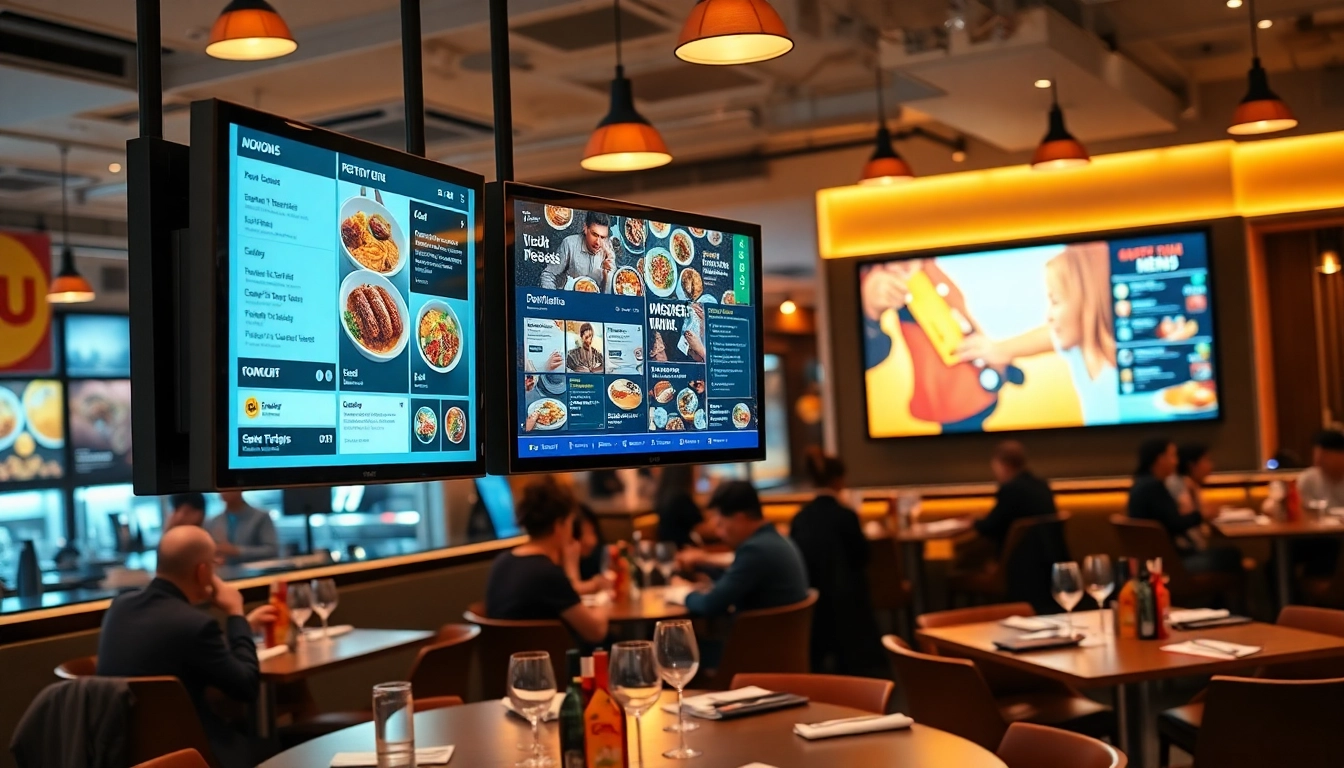Understanding Digital Signage for Restaurants
Definition and Importance
Digital signage refers to electronic displays that showcase content relevant to a specific audience in various formats such as videos, images, and animations. In the restaurant industry, these displays serve pivotal roles, ranging from conveying menus to promoting special offers. The importance of digital signage in restaurants cannot be overstated; as dining establishments face increasing competition, effective communication strategies become vital. With appropriate Digital signage for restaurants, owners can create engaging experiences that attract customers and enhance satisfaction.
Key Features of Digital Signage
Digital signage for restaurants encompasses several key features:
- Dynamic Content Display: Allows for real-time updates and visually appealing presentations.
- Remote Management: Enables managers to modify content across multiple screens from a single location.
- Integration Capabilities: Compatibility with various software and tools, such as POS systems.
- Interactivity: Capability for touch-screen technology to enhance customer engagement.
- Analytics: Tools to track customer interactions and measure the effectiveness of displayed content.
Industry Trends in Restaurant Signage
As technology evolves, so do trends in digital signage for restaurants. Here are some current movements:
- Personalization: Tailoring content based on customer demographics and preferences.
- Contactless Technology: Integration with mobile devices for ordering and payments.
- Video Walls: Creating immersive environments that capture patrons’ attention.
- AI-Powered Content: Utilizing artificial intelligence to optimize messaging and engagement.
Benefits of Digital Signage for Restaurants
Improved Customer Engagement
Digital signage enhances customer engagement by providing visually stimulating experiences. Dynamic content can capture attention effectively, making interactions more memorable. For instance, video snippets of chefs preparing signature dishes or customer testimonials can significantly enrich the dining experience.
Dynamic Menu Updates
Flexibility is one of the hallmarks of digital signage. Restaurateurs can promptly update menu items and prices, ensuring patrons receive the latest information. During peak hours, featuring daily specials or highlighting popular items can optimize sales and reduce wait times.
Increased Sales through Promotions
Promotional campaigns can be rapidly implemented and displayed across multiple screens. Seasonal offers, happy hour specials, or discounts can find a prominent place on digital displays, increasing the visibility of these deals and driving impulse purchases. Case studies have shown that strategically placed promotions can lead to sales lifts of up to 30%.
Implementing Digital Signage in Your Restaurant
Choosing the Right Equipment
Before integrating digital signage, it’s crucial to select the appropriate equipment. Options range from LCD screens to OLED displays. Considerations include size, resolution, brightness, and whether indoor or outdoor placement is preferred. Techniques such as restaurant layout planning can determine optimal screen placement for maximum visibility.
Content Creation and Management Strategies
Creating engaging content is vital for successful digital signage. Here are key strategies:
- Visual Design: Use high-resolution images and videos with clear messaging.
- Content Variety: Mix promotional content, menu highlights, and customer testimonials to keep displays fresh.
- Scheduling: Implement a content calendar that aligns with dining trends and operable hours.
- Feedback Loop: Analyze performance metrics and make necessary adjustments for optimal engagement.
Installation and Maintenance Considerations
Installation should be carried out by professionals to ensure safety and functionality. Moreover, ongoing maintenance is crucial to prevent tech glitches. Regularly updating software and conducting checks on display hardware can minimize downtime and keep displays running efficiently.
Challenges and Solutions in Digital Signage for Restaurants
Common Technical Issues
While digital signage offers numerous advantages, it can present some technical challenges. Common issues include software malfunctions, connectivity problems, and hardware failures. To address these, investing in reliable tech support can mitigate risks and ensure that displays operate seamlessly.
Budget Constraints and ROI
Budgeting for digital signage can be a concern for many restaurants, especially small businesses. It’s essential to evaluate both initial investment and long-term ROI. Establishing measurable goals, such as increased sales from promotions, can make a compelling case for initial expenditures. Employing financing options or leasing can also help manage costs effectively.
User Acceptance and Training
Adoption of digital signage can face resistance from staff, particularly if they are accustomed to traditional methods. Proper training sessions are fundamental to ensure that all employees understand how to operate the system effectively. Developing a culture of innovation within the restaurant can foster acceptance and enthusiasm for new technologies.
Measuring the Success of Digital Signage Investments
Key Performance Indicators (KPIs)
To measure the effectiveness of digital signage, restaurants should establish specific key performance indicators (KPIs). These may include:
- Sales growth from promotions displayed on screens.
- Customer dwell time in front of displays.
- Engagement rates as measured by customer interactions with displayed content.
Customer Feedback and Interaction
Direct customer feedback is invaluable in understanding digital signage impact. Encouraging patrons to share their experiences can provide insights into content effectiveness and areas for improvement. Implementing surveys or interactive feedback buttons can enhance this interaction.
Adapting Strategies Based on Analytics
Data analytics plays a critical role in refining digital signage strategies. By analyzing customer interactions and sales data, restaurant managers can identify which types of content resonate most with patrons. Adjusting strategies accordingly can lead to continued growth and enhanced customer satisfaction.
